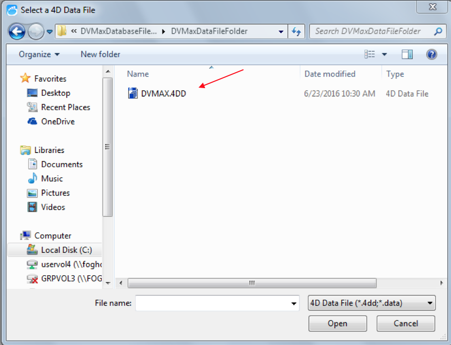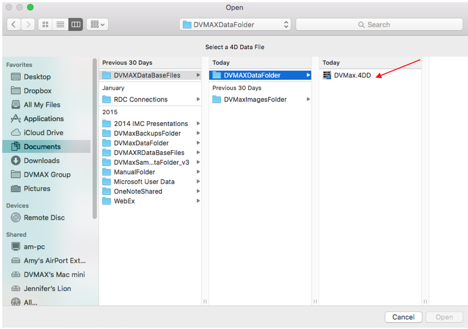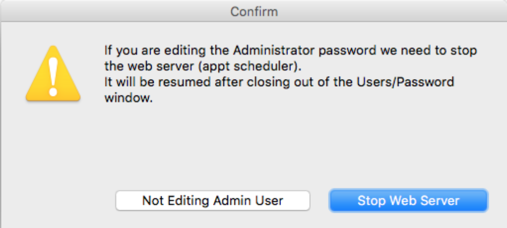Upgrading to the Current DVMAX Server Version from DVMAX v7.6 or higher
Current Version: DVMAX v8.8
This document will outline how to upgrade your DVMAX v7.6 - 8.7 server application to DVMAX v8.8. This upgrade can be done by the practice or an IT technician and does not require an appointment with the Upgrades Department. If you are using DVMAX v7.5, v7.0.12, or older versions, please refer to our Upgrade Process by Version document.
IMPORTANT
If you are using Remote Processing, please call DVMAX Technical Support (800-950-5455) to discuss specific instructions regarding this upgrade. Remote processing clinics must schedule an appointment with support for upgrade assistance of their remote terminals BEFORE starting the upgrade process. All remote terminals must be available during the upgrade.
If you are an MPA practice, please call DVMAX Technical Support (800-950-5455) prior to upgrading. (All MPA locations must be upgraded within the same 24 hour time period).
If you are an rVetLink user, please call DVMAX Technical Support (800-950-5455) prior to upgrading.
Pre-Install Checklist
We have implemented a new 4D Write Pro Word Processing module so that the DVMAX Client application could be supported on 64-bit operating systems. With this upgrade, there are a few steps you must take PRIOR to performing the steps below.
- Verify that all of your workstations run on a 64-bit operating systems. DVMAX Client will no longer run on a 32-bit operating system.
- Save any logos or pictures pasted into your word processing documents; these pictures may not convert during the upgrade process.
- Make note of any word processing documents you will be using shortly after upgrade. You will want to review these after the upgrade to make sure there are no formatting edits necessary.
- If you are using our Integrated Credit Card processing feature, please verify that you are using EMV compliant devices. You must be EMV compliant before upgrading. Please contact OpenEdge at 1-888-560-0975 if you have questions about compliance.
- The faxing service in all DVMAX versions ended in June 2020.
- If you are using IDEXX rVetLink, there are additional step you must take during the upgrade and you must schedule an appointment to reactivate your integration after performing the DVMAX upgrade. Please contact DVMAX Technical Support at 800-950-5455 prior to upgrading to get the additional upgrade steps.
(The full checklist can be found here - Pre-Install Checklist for Upgrading to DVMAX v8.8)
Review System Requirements before proceeding: System Requirements for the Current DVMAX Release
![]() (Support for Mac OS 10.10/10.11, Windows XP/Vista, and 32-bit Operating Systems has ended!)
(Support for Mac OS 10.10/10.11, Windows XP/Vista, and 32-bit Operating Systems has ended!) ![]()
![]() (Support for Macintosh computers manufactured in 2007 or earlier has ended!)
(Support for Macintosh computers manufactured in 2007 or earlier has ended!) ![]()
Before you begin:
Reach out to DVMAX Support at (800) 950-5455 to get a link for the latest installer
Export Users and Passwords
- Login to DVMAX Client as the Administrator user.
- From the Section menu, select General Management.
- The General Management dialog opens. Click the Utilities tab.
- Select the Set Passwords & Users and click OK. The Tool Box opens.
- Click the Groups icon on the left side of the window to change to the Groups view.
- Click on the Gear icon at the bottom right and choose Save Users and Groups.
- The Save As dialog will open.
- Select your Desktop, name the file passwords8 and click Save.
- Close the Tool Box by clicking X in the window title bar.
- Close the DVMAX. From the DVMAX menu, select Quit.
Backup your DVMAX Data
- On DVMAX Server, go to File -> Backup.
- When the Backup dialog appears, click the Backup button.
- When the Backup is finished, Proceed to Step 3.
If you'd like to make a manual copy of your data instead...
- Quit DVMAX Server.
- Copy your datafile, typically located in:
Macintosh: Macintosh HD:DVMAXDatabaseFiles:DVMAXDataFolder
Windows: C:/DVMAXDatabaseFiles/DVMAXDataFolder/
We highly recommend storing this backup on an external hard drive until you are satisfied with the integrity of the data following the upgrade.
Disable Log File
- Click on the Maintenance Tab, then click on the Preferences button to configure your backup.
- Click the Configuration tab.
- Uncheck the Use Log File box. A dialog will ask you to confirm. Click Stop (You will reactive the log file after the upgrade)
- Click OK to save the Backup settings
- Go to the DVMAX DataFileFolder and either rename or delete the .Journal file
- Windows typical path: C:/DVMAXDatabasefiles/DVMAXDatafileFolder
- Mac typical path: Documents/DVMAXDatabasefiles/DVMAXDatafileFolder
Unregister the 4D Service (For Windows computers only)
If the Server application is running as a service, you will need to stop the service, then manually launch DVMAX Server on the local admin account. The rest of the steps that take place within the Server application will be done on the locally launched instance.
All users should be logged off DVMAX Client workstations before proceeding.
To unregister the 4D Service:
- Stop the 4D Service currently running on the server
- Right-click on My Computer
- Choose Manage
- Click on Services and Applications
- Click on Services
- Highlight 4D Server: DVMAX and click Stop
- Launch DVMAX Server application locally
- From the File menu, select Unregister all Server services.
- If Unregister all Server Services is unavailable (i.e. you cannot select it), then the 4D Service has already been unregistered.
- If there are no unregister options are available, the DVMAX Server is still running as a service.
- From the File menu choose Quit.
Uninstall Existing DVMAX Software
Windows:
- If open, quit the DVMAX Server application
- From the File pull-down, choose Quit
- Go to Start -> Control Panel -> Add/Remove Programs or Programs and Features
- Highlight DVMAX in the list and click Uninstall/Remove
- Verify no residual files exist:
- Navigate to C:/Program Files (x86)/
- Locate the DVMAXProgramFiles75 (Could be named DVMAX Practice) folder (if it exists) and delete it.
Macintosh:
- If open, quit the DVMAX Server application
- From the DVMAX pull-down, choose Quit
- Browse to your Applications folder.
- Click and Drag your DVMAXProgramFiles75 (Could be named DVMAX Practice) folder to the trash.
Install DVMAX Software
- Locate the DVMAX installer - Contact DVMAX Technical Support at 800-950-5455 for a link to the installer
- If you receive any errors during the installation process on Windows, cancel the install and right click the installer, then choose Run as Administrator.
Note: On Window, 64-Bit server is the only option.
- Follow the Installer prompts (On Windows: Choose Typical)
Launch DVMAX Server
- Double click DVMAX Server on the Desktop.
- At the first prompt, click OPEN to select a datafile.
- Point DVMAX to your datafile and click Open. (your datafile will end in .4DD or .data)
Typical Path on Windows: C:DVMAXDatabaseFiles:DVMAXDataFolder OR D:DVMAXDatabaseFiles:DVMAXDataFolder *Be sure to check both the C: and D: drive if you have having trouble finding the datafile.
Typical Path on Macintosh: Documents: DVMAXDatabaseFiles:DVMAXDataFolder OR MacintoshHD:DVMAXDatabaseFiles:DVMAXDataFolder
- If you are asked to point to a log file, navigate to the .4BL file in the DVMAXDataFolder and choose to open. If you receive an error that the log file was unable to be integrated, choose Create New and save in the DVMAXDataFolder.
- The new DVMAX Server application will open and the data upgrade process will begin. During the upgrade process you will see a resetting window that pops up first. Do not Quit the server during this reset or it will start over.
Configure Backup
NOTE: If you are using the DVMAX Data Backup and Recovery service, please contact DVMAX Technical Support (800-950-5455) for final configuration of the service before configuring the backup.
We recommend the following configuration:
- Click on the Maintenance Tab, then click on the Preferences button to configure your backup.
- Change Automatic Backup to Daily.
- Set the time (military format) for when your practice is least busiest or closed.
- Click the Configuration tab.
- In the Attachments area, click 'Add File...'
- Point to the location of your datafile folder and select the .4DIndx, 4DSyncData, .4DSyncHeader, and .Match files as attachments.
- For the Backup Destination, click the '...' button to the right.
- Set the Backup Destination to your DVMAXBackupsFolder, typically located in:
C:/DVMAXDatabaseFiles/DVMAXBackupFolder on Windows
Macintosh HD:Documents:DVMAXDatabaseFiles:DVMAXBackupFolder on Macintosh
- Check the Use Log File box. A dialog will ask you where to save the Journal File. Save it in the same folder as your data, typically located in:
C:/DVMAXDatabaseFiles/DVMAXDataFolder on Windows
Macintosh HD:Documents:DVMAXDatabaseFiles:DVMAXDataFolder on Macintosh
- Click the Backup & Restore tab.
- Set the If Backup Fails choice to Retry at the Next Scheduled Date and Time, or any other option of your liking. If you set it to retry differently, make sure you check the box to Cancel the operation after a certain number of attempts to avoid endless backup attempts and failures.
- Set the Segment Size to 1500
- Click OK to save the Backup settings - DVMAX will then perform it's first backup
NOTE: The DVMAX Server does not automatically back up the DVMAXImagesFolder. If you are using the DVMAX Attachments/Imaging feature, that folder will need to be backed up separately/manually.
We also strongly urge you to invest in an offsite backup solution. IDEXX offers a Data Backup and Recovery service, or your IT technician can suggest other solutions. If you're interested in learning about IDEXX Data Backup and Recovery, please reach out to DVMAX Sales at 800-877-9221 ext 1.
Windows Only: Configure Windows Firewall
Depending on your setup, Windows Firewall might be active on your server. It is important to exclude DVMAX from Windows Firewall so that other computers can connect to DVMAX Server.
- Choose Start -> Control Panel
- Locate Windows Firewall and open it.
- If you do NOT see it, locate 'System & Security' and Open it - then choose Windows Firewall from there.
- On the left - if Windows Firewall is ON, choose 'Allow a program through Windows Firewall'.
- A list of Applications will appear. Click Browse at the bottom and point to DVMAX Server.
Set DVMAX Server up as a Service (Windows) or Set DVMAX Server to Open at Login (Macintosh)
We recommend running the DVMAX Server application as a service on Windows servers. Complete documentation on how to configure DVMAX Server as a service can be found in our Running DVMAX Server Application as a Service document.
We recommend setting the DVMAX Server application to open at login on Macintosh servers. Complete documentation on how to configure this setting can be found in our Set DVMAX Server Application to Open at Login document.
Upgrade/Update DVMAX Client on Workstations
![]() There is a new auto-update feature for the DVMAX Client application installed on Macintosh workstations. Due to security configurations at each location, we cannot guarantee the DVMAX client application will auto-update. If you have a Macintosh server, DVMAX Client should auto-update on most Macintosh workstations on which the user is logged in as the Administrator user. If you have a Windows server and/or Windows workstations, the auto-update feature will be available after your v8.8 upgrade. This means versions after v8.8 should auto-update on Windows.
There is a new auto-update feature for the DVMAX Client application installed on Macintosh workstations. Due to security configurations at each location, we cannot guarantee the DVMAX client application will auto-update. If you have a Macintosh server, DVMAX Client should auto-update on most Macintosh workstations on which the user is logged in as the Administrator user. If you have a Windows server and/or Windows workstations, the auto-update feature will be available after your v8.8 upgrade. This means versions after v8.8 should auto-update on Windows.
Macintosh
- Log into the workstation as the Administrator user
- Open your existing DVMAX Client application. You will see a message that says the 4D version of the Client application is different from the Server application. Choose the option to update. There will be a slight delay before the application opens as the application runs through the auto-update.
- You will know the auto-update is successful if the client application opens and loads DVMAX.
- If the auto-update fails, please see the Installing DVMAX Client instructions for assistance on removing old versions and installing the current version.
Windows
- You must uninstall/remove previous versions of DVMAX Client before installing the most recent version
- Please see the Installing DVMAX Client instructions for assistance.
Import Passwords
- Login to DVMAX Client as the Administrator user (password will be blank) if you have not done so already.
- From the Section menu, select General Management. The Management Functions dialog opens.
- Click the Utilities tab.
- Select Set Passwords & Users and click OK.
- After selecting Set Passwords and Users, you will see the following alert:
- Choose Not Editing Admin User
- The Tool Box opens.
- Click the Groups icon on the left side of the window to change to the Groups view.
- Click on the Gear icon at the bottom right and choose Load Users and Passwords.
- Click Desktop and select the Passwords8 file you saved before beginning your upgrade and click Open. Users and Passwords are loaded.
- Click the Users icon on the left side of the screen.
- If desired, select the Administrator user and click Edit to set a password for this user.
- Enter the desired password, confirm the password, and click Change.
- Click the X in the window title bar to close the Tool Box.
- Quit DVMAX and restart the application before proceeding
Turn on Web Server
- You must be on the server computer for this step
- Locate the DVMAX Server application
- From the list of icons at the top, choose HTTP Server
- Click Start HTTP Server
Verify Lab Setting (If using IDEXX Reference Lab)
- Login to DVMAX Client as the Administrator user if you have not done so already.
- From the File menu, select Preferences. The DVMAX Preferences dialog opens.
- Click on Lab Result Setup
- If the Use VC Agent Radio button is selected, choose Use VC4 Lab Services
- If Use VC4 Lab Services is already selected, no further changes need to be made
- Click OK to close the DVMAX Preferences window.
Enable Replication Setting (If using Remote Processing Feature)
- Log into DVMAX Client as Administrator
- Click Section → Hold SHIFT → Click System Constants.
- At the prompt, click I Understand
- Click on the Functions tab
- Click Execute method and type: rp_InitializeTables
- Click OK.
- The Program will enable REPLICATE as needed. It will take roughly 5-15 minutes, depending on the size of the data and the speed of the machine.
- When the process is done, the progress dialog will disappear, and you will be able to close out of Advanced Settings.
- No reboot of DVMAX is necessary.
Toss Browser Cache on all Workstations
*NOTE: These steps may vary based on browser version and operating system
- Macintosh and Windows - Cache File Removal for DVMAX v7.6r2 and above#BrowserCacheRemoval
Optimal Settings on Workstations
Ensure optimal settings are configured on each workstation, including the server:
- Macintosh - Optimal Settings for DVMAX on Macintosh
- Windows - Optimal Settings for DVMAX on Windows
Email Support
Please email our support team at DVMAXSupport@idexx.com to let us know the upgrade was successful. We will update our records as soon as we have been notified that you've upgraded.
Review v8.8 Resources
Review resources available for DVMAX Anywhere, our new Word Processing module, and the new SmartFlow integration - DVMAX v8.8 Resources


